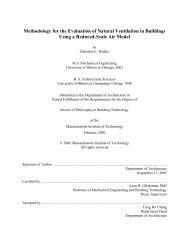Spring 2012 - Cham
Spring 2012 - Cham
Spring 2012 - Cham
Create successful ePaper yourself
Turn your PDF publications into a flip-book with our unique Google optimized e-Paper software.
Wind directionNoonNorthMeshSun positionIn our test case, the wind and sun conditions arerepresentative of the UK (Gatwick) in April.The radiative heat transfer is handled by IMMERSOL.The surface emissivities are set as follows:Ground - 0.9Grass - 1.0Road - 0.5River - 1.0Building - 1.0The radiative heat loss to the sky is represented bya radiative heat loss to an external temperature of -2˚Cwith an emissivity of 1.0.It should be noted that in order to radiate 500w/m 2to an external temperature of -2˚C, the requiredtemperature is 72˚C. After around 1200 sweeps theaverage temperature over the entire ground plane justbelow the surface is 67˚C. The temperature of the roadwhich has a lower emissivity is higher, again in line withexpectation. However, given that the surfacetemperatures are not actually that high in reality, theremust be some other mechanism for heat loss.Although in this case the model is set with userdefinedinputs, both the sun and wind parameters canbe imported from an EPW weather file (eg the publicdomain Energy Plus database.)• Wind direction – East• Wind speed - 2.5 m/s at 10m• Logarithmic wind profile• Roughness height - 0.1m• Ambient temperature - 12˚C• Ground temperature - 9˚C• Sun latitude 51deg• Direct radiation 400 W/m2• Diffuse radiation 100 W/m2LitShadingSurface TempIn this example, the ground surrounding thebuildings, road, grass and river all have a Z depth of 2m.The ground temperature of 9˚C is applied at the lowerface of the ground. This represents the constant earthtemperature underground.ConclusionThe prototype heat island module demonstratesadequately the ability of PHOENICS to simulateprocesses of this type. Whilst there is alreadyconnectivity with weather mapping data bases, themodule still remains as a working template, relying uponthe user to specify appropriate materials, and theiremissivity and absorptivity values.4
















